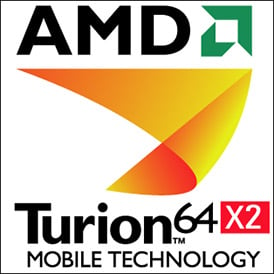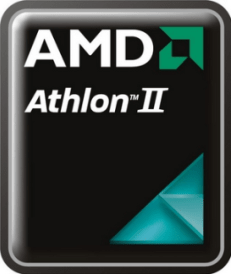AMD Turion 64 MK-36 vs AMD Athlon II X3 420e
Last updated:
CPU comparison with benchmarks

|

|
|
| AMD Turion 64 MK-36 | AMD Athlon II X3 420e | |
CPU comparisonIn this CPU comparison, we compare the AMD Turion 64 MK-36 and the AMD Athlon II X3 420e and use benchmarks to check which processor is faster.
We compare the AMD Turion 64 MK-36 1 core processor released in Q3/2006 with the AMD Athlon II X3 420e which has 3 CPU cores and was introduced in Q3/2010. |
||
| AMD Turion (1) | Family | AMD Athlon II (52) |
| AMD Turion 64 MK (1) | CPU group | AMD Athlon II X3 (Rana) (12) |
| 2 | Generation | 1 |
| Richmond | Architecture | Rana |
| Mobile | Segment | Desktop / Server |
| -- | Predecessor | -- |
| -- | Successor | -- |
|
|
||
CPU Cores and Base FrequencyThe AMD Turion 64 MK-36 is a 1 core processor with a clock frequency of 2.00 GHz. The processor can compute 1 threads at the same time. The AMD Athlon II X3 420e clocks with 2.60 GHz, has 3 CPU cores and can calculate 3 threads in parallel. |
||
| AMD Turion 64 MK-36 | Characteristic | AMD Athlon II X3 420e |
| 1 | Cores | 3 |
| 1 | Threads | 3 |
| normal | Core architecture | normal |
| No | Hyperthreading | No |
| No | Overclocking ? | No |
| 2.00 GHz | Frequency | 2.60 GHz |
| -- | Turbo Frequency (1 Core) | -- |
| -- | Turbo Frequency (All Cores) | -- |
Memory & PCIeUp to 8 GB of memory in a maximum of 2 memory channels is supported by the AMD Turion 64 MK-36, while the AMD Athlon II X3 420e supports a maximum of 16 GB of memory with a maximum memory bandwidth of 21.3 GB/s enabled. |
||
| AMD Turion 64 MK-36 | Characteristic | AMD Athlon II X3 420e |
| DDR2-800 | Memory | DDR3-1333 |
| 8 GB | Max. Memory | 16 GB |
| 2 (Dual Channel) | Memory channels | 2 (Dual Channel) |
| 12.8 GB/s | Max. Bandwidth | 21.3 GB/s |
| No | ECC | No |
| 0.50 MB | L2 Cache | 1.50 MB |
| -- | L3 Cache | -- |
| -- | PCIe version | 2.0 |
| -- | PCIe lanes | -- |
| -- | PCIe Bandwidth | -- |
Thermal ManagementThe AMD Turion 64 MK-36 has a TDP of 31 W. The TDP of the AMD Athlon II X3 420e is 45 W. System integrators use the TDP of the processor as a guide when dimensioning the cooling solution. |
||
| AMD Turion 64 MK-36 | Characteristic | AMD Athlon II X3 420e |
| 31 W | TDP (PL1 / PBP) | 45 W |
| -- | TDP (PL2) | -- |
| -- | TDP up | -- |
| -- | TDP down | -- |
| -- | Tjunction max. | -- |
Technical detailsThe AMD Turion 64 MK-36 has 0.50 MB cache and is manufactured in 90 nm. The cache of AMD Athlon II X3 420e is at 1.50 MB. The processor is manufactured in 45 nm. |
||
| AMD Turion 64 MK-36 | Characteristic | AMD Athlon II X3 420e |
| 90 nm | Technology | 45 nm |
| Unknown | Chip design | Unknown |
| x86-64 (64 bit) | Instruction set (ISA) | x86-64 (64 bit) |
| MMX, SSE, SSE2, SSE3, Extended 3DNow! | ISA extensions | MMX, 3DNow!, SSE3, SSE4a |
| S1 | Socket | AM3 |
| AMD-V | Virtualization | AMD-V |
| No | AES-NI | No |
| Operating systems | Windows 10, Linux | |
| Q3/2006 | Release date | Q3/2010 |
| -- | Release price | -- |
| show more data | show more data | |
Rate these processors
Average performance in benchmarks
⌀ Single core performance in 1 CPU benchmarks
⌀ Multi core performance in 1 CPU benchmarks
Geekbench 5, 64bit (Single-Core)
Geekbench 5 is a cross plattform benchmark that heavily uses the systems memory. A fast memory will push the result a lot. The single-core test only uses one CPU core, the amount of cores or hyperthreading ability doesn't count.
|
|
AMD Turion 64 MK-36
1C 1T @ 2.00 GHz |
||
|
|
AMD Athlon II X3 420e
3C 3T @ 2.60 GHz |
||
Geekbench 5, 64bit (Multi-Core)
Geekbench 5 is a cross plattform benchmark that heavily uses the systems memory. A fast memory will push the result a lot. The multi-core test involves all CPU cores and taks a big advantage of hyperthreading.
|
|
AMD Turion 64 MK-36
1C 1T @ 2.00 GHz |
||
|
|
AMD Athlon II X3 420e
3C 3T @ 2.60 GHz |
||
Cinebench R23 (Single-Core)
Cinebench R23 is the successor of Cinebench R20 and is also based on the Cinema 4 Suite. Cinema 4 is a worldwide used software to create 3D forms. The single-core test only uses one CPU core, the amount of cores or hyperthreading ability doesn't count.
|
|
AMD Turion 64 MK-36
1C 1T @ 2.00 GHz |
||
|
|
AMD Athlon II X3 420e
3C 3T @ 2.60 GHz |
||
Cinebench R23 (Multi-Core)
Cinebench R23 is the successor of Cinebench R20 and is also based on the Cinema 4 Suite. Cinema 4 is a worldwide used software to create 3D forms. The multi-core test involves all CPU cores and taks a big advantage of hyperthreading.
|
|
AMD Turion 64 MK-36
1C 1T @ 2.00 GHz |
||
|
|
AMD Athlon II X3 420e
3C 3T @ 2.60 GHz |
||
Cinebench R20 (Single-Core)
Cinebench R20 is the successor of Cinebench R15 and is also based on the Cinema 4 Suite. Cinema 4 is a worldwide used software to create 3D forms. The single-core test only uses one CPU core, the amount of cores or hyperthreading ability doesn't count.
|
|
AMD Turion 64 MK-36
1C 1T @ 2.00 GHz |
||
|
|
AMD Athlon II X3 420e
3C 3T @ 2.60 GHz |
||
Cinebench R20 (Multi-Core)
Cinebench R20 is the successor of Cinebench R15 and is also based on the Cinema 4 Suite. Cinema 4 is a worldwide used software to create 3D forms. The multi-core test involves all CPU cores and taks a big advantage of hyperthreading.
|
|
AMD Turion 64 MK-36
1C 1T @ 2.00 GHz |
||
|
|
AMD Athlon II X3 420e
3C 3T @ 2.60 GHz |
||
Estimated results for PassMark CPU Mark
Some of the CPUs listed below have been benchmarked by CPU-monkey. However the majority of CPUs have not been tested and the results have been estimated by a CPU-monkey’s secret proprietary formula. As such they do not accurately reflect the actual Passmark CPU mark values and are not endorsed by PassMark Software Pty Ltd.
|
|
AMD Turion 64 MK-36
1C 1T @ 2.00 GHz |
||
|
|
AMD Athlon II X3 420e
3C 3T @ 2.60 GHz |
||
Cinebench R15 (Single-Core)
Cinebench R15 is the successor of Cinebench 11.5 and is also based on the Cinema 4 Suite. Cinema 4 is a worldwide used software to create 3D forms. The single-core test only uses one CPU core, the amount of cores or hyperthreading ability doesn't count.
|
|
AMD Turion 64 MK-36
1C 1T @ 2.00 GHz |
||
|
|
AMD Athlon II X3 420e
3C 3T @ 2.60 GHz |
||
Cinebench R15 (Multi-Core)
Cinebench R15 is the successor of Cinebench 11.5 and is also based on the Cinema 4 Suite. Cinema 4 is a worldwide used software to create 3D forms. The multi-core test involves all CPU cores and taks a big advantage of hyperthreading.
|
|
AMD Turion 64 MK-36
1C 1T @ 2.00 GHz |
||
|
|
AMD Athlon II X3 420e
3C 3T @ 2.60 GHz |
||
Devices using this processor |
|
| AMD Turion 64 MK-36 | AMD Athlon II X3 420e |
| Unknown | Unknown |
Popular comparisons containing this CPUs
back to index


